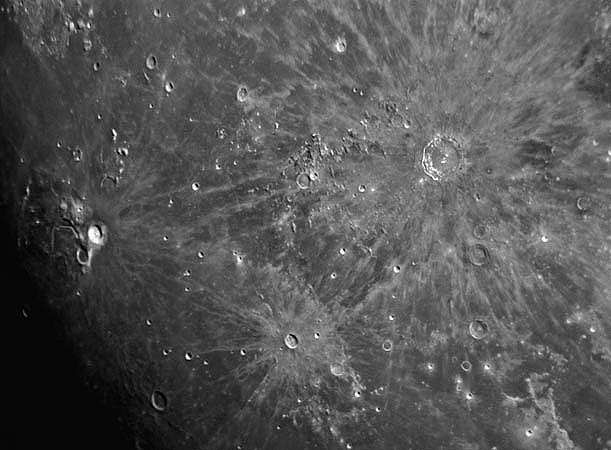Difference between revisions of "May 8, 2005"
| Line 1: | Line 1: | ||
__NOTOC__ | __NOTOC__ | ||
=Splayed Rays= | =Splayed Rays= | ||
| + | <!-- Start of content --> | ||
<table width="85%" border="0" align="center" cellpadding="6" cellspacing="2"> | <table width="85%" border="0" align="center" cellpadding="6" cellspacing="2"> | ||
<tr> | <tr> | ||
| Line 50: | Line 51: | ||
</table> | </table> | ||
<p> </p> | <p> </p> | ||
| + | <!-- End of content --> | ||
{{wiki/ArticleFooter}} | {{wiki/ArticleFooter}} | ||
Revision as of 18:36, 7 February 2015
Splayed Rays
Image Credit: Christophe Behaegel |
|
Splayed Rays Did you ever put a magnet under a sheet of paper and sprinkle iron fillings on top? Did you ever do it with three magnets? If so youd get something similar to this high sun view of rays splaying out from Copernicus (top right), Kepler (lower center) and Aristarchus (middle left). The rays radiate in all directions, and some seem to connect the three craters into a giant triangle. This image shows the variations in the nature of rays, even at a single crater. Rays are perhaps the most difficult type of lunar features to classify, and no classification scheme is commonly used to describe their shapes. Most of the rays from these three craters are relatively narrow but some are much wider. Copernicus has narrow, wispy rays extending in all directions, and wide, semi-parallel rays leading towards Aristarchus and crossing Imbrium. Keplers rays are mostly thin and non-distinct to the east, but there are four broad rays to the west, with sharp boundaries with the maria. Aristarchus rays are the least conspicuous of the three, and are most visible to its east. All three craters are surrounded by broad annular regions about 1-2 crater diameters wide. This is equivalent to the bright nimbus often seen around tiny fresh craters at full Moon. Curiously, there is not a modern catalog of rayed craters; one must go back to the classical moon mappers such as Schmidt and Elger to find a thorough listing. Related Links: Yesterday's LPOD: Buried and Textured Tomorrow's LPOD: NOT the Source of Lunar Nomenclature |
|
Author & Editor: Technical Consultant: Contact Translator: A service of: |
COMMENTS?
Register, Log in, and join in the comments.




